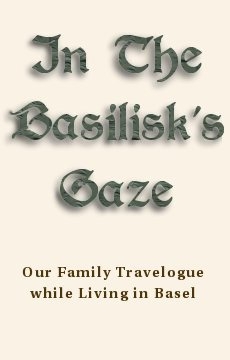Second Great European Holiday
 Tuesday, August 17, 2010 at 10:40AM
Tuesday, August 17, 2010 at 10:40AM In July, we set off eastward for an 18-day summer driving holiday. Our first stop was lunch in Friedrichshafen, reached by taking the car ferry across Lake Constance from Konstanz to Meersburg. We ate in a terrace restaurant overlooking the glittering lake, but we didn’t have time to stop in at the Zeppelin Museum — we were due in Munich by 4pm 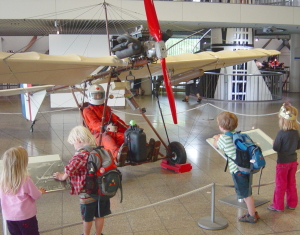 when the World Cup quarter-final between Germany and Argentina would begin.
when the World Cup quarter-final between Germany and Argentina would begin.
As it was, we got caught in traffic coming into Munich, almost every car sporting a fluttering German flag, and missed the first ten minutes of the match. When we reached Georg and Dani’s house, Thomas Müller had already scored the first of Germany’s four unanswered goals. Everyone was ecstatic with the result.
Over the next few days, Wiki and Loxon spent time with Dani and Georg’s daughters, Elena and Filiz, their trampoline being a particular source of excitement. We visited the Munich Zoo, checked out the old city centre and spent some time at the Deutsche Museum, where all four kids were fascinated by the boats, submarines, planes and rockets on display. Loxon asked if the man in the ultra-light (pictured above) was real or not. Perhaps he thought the man had just landed, popping in to check out the exhibits like everyone else. Meanwhile Wiki took careful note of the World War 2 rockets, with designs on building his own. Fortunately for everyone he’ll have trouble getting his hands on the necessary fuel.
We then headed off to an old Bavarian hotel in Gstadt, a village on the shores of the famous Chiemsee lake to the east of Munich. We lay on the shore and enjoyed the sun, while Wiki and Loxon splashed about 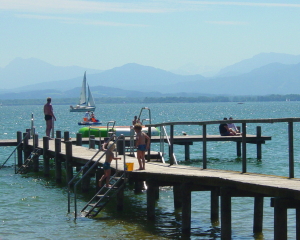 against the background of mountains and islands. And we rented a pedal boat to survey the huge private lakeside mansions, complete with their own yacht marinas.
against the background of mountains and islands. And we rented a pedal boat to survey the huge private lakeside mansions, complete with their own yacht marinas.
While there, we also made a day trip to Berchtesgaden in the southeast corner of Germany to visit the salt mine. Wearing special overalls, you board a small open-topped train and rattle through pitch black tunnels into the bowels of a mountain. Inside, you can slide down wooden slip rails to go deeper and cross an underground lake by barge while a laser light show plays on the cave walls. There are also great displays showing how fresh water is used to dissolve salt from the rocks and is then pumped back to the surface.
We continued into Austria, stopping for lunch in heavily touristed Salzburg. Wiki became nauseous as we approached the city, possibly due to an allergy against kitsch, but he recovered enough to be carried around the sights of the town, including the house where Mozart was born.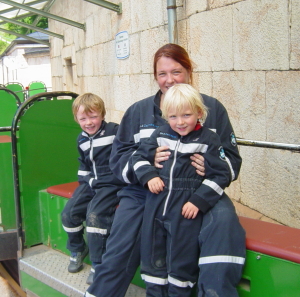
Our next stop was a visit to our friends, Eva and Christoph, in the Austrian alps. Their house sits on a hilltop above the town of Scharnstein, with incredible views down the Alm valley. As you can see below, they have a fantastic pool whose landscaping incorporates a waterplant garden. Christoph served one meal after another of delicious locally produced food, some of which the boys even picked from the garden themselves. Every piece of meat we ate came from a local animal that Christoph had known when it was alive.
From there we drove to Vienna, stopping for lunch at the Benedictine abbey in Melk (the protagonist in Umberto Eco’s The Name of the Rose is supposed to have come from here). The weather had been unusually warm so far, but now it became a heat wave. When we arrived at Alexandra and Martin’s house the temperature was in the high thirties.
The boys held up well in the heat as we marched around the grand monuments of Vienna, strolled the Belvedere gardens and explored the Naschmarkt. 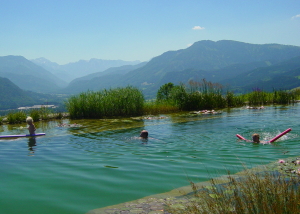 A plethora of gold and silver painted street performers, sweating in sealed costumes, helped keep them entertained. They were also excited to feed the rabbits owned by Lauren and Levin, Alexandra and Martin’s young sons.
A plethora of gold and silver painted street performers, sweating in sealed costumes, helped keep them entertained. They were also excited to feed the rabbits owned by Lauren and Levin, Alexandra and Martin’s young sons.
After a day or so, both our families packed up and drove the 45 minutes out to Alexandra’s family’s holiday house on the shores of Lake Neusiedl. Despite covering over 300 square kilometres, this lake between Austria and Hungary is nowhere more than 2 metres deep. The four kids ran around together on the back lawn, spraying water and having fun, while the adults relaxed in the shade. We also used the family’s pedal boat to trundle out onto the lake and around to a public beach, where everyone could go swimming.
On our last day there, we drove around the lake to the Neusiedlersee Family Park, a theme park with dozens of rides, displays, animals and play areas. The boys weren’t sure how they felt about the rather scary three-metre tall dragon that lurked inside one cave and sprayed onlookers with mist, 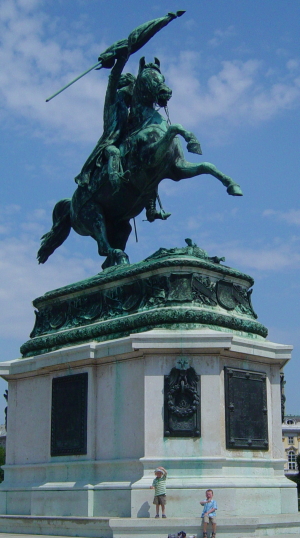 but they loved the huge water slide, whose rubber boats picked up tremendous speed, and feeding deer through the fence, including one large Red Deer stag who came close enough to touch his metre-long antlers.
but they loved the huge water slide, whose rubber boats picked up tremendous speed, and feeding deer through the fence, including one large Red Deer stag who came close enough to touch his metre-long antlers.
Then came the long drive home, broken up by a stopover in Ulm. We tried to reach Ulm in time to see the Nabada water festival, held that afternoon. But by the time we arrived, it was over and the after-party was beginning. Given how many people were still there, it would have been impossible to get a decent view anyway — on the way back to our car, we encountered a human traffic jam and had to circle back half a kilometre to get through to our car. We contented ourselves with dining in a beer garden overlooking the now deserted Danube as the sun set and the crowds drifted away.
Before setting off for home the next morning, we visited Ulm’s towering Minster (technically not a cathedral since it has never been the seat of a bishop). It was the tallest building in the world when it was completed in 1890, and remained so until 1901, the start of America’s century — from then until 1998 the world’s tallest building was in the United States. The Minster was the last in a line of eight European cathedrals and churches to be the world’s tallest building, spanning six centuries. In fact, it had taken almost that long to build — the foundation stone was laid in 1377. Before them, the Great Pyramid at Giza has held the title for almost three millenia.
